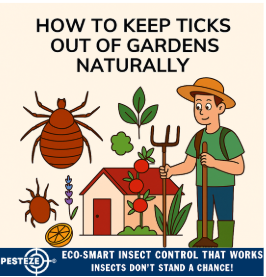HOW TO KEEP TICKS OUT OF GARDENS NATURALLY

HOW TO KEEP TICKS OUT OF GARDENS NATURALLY
SUMMARY
Gardens are wonderful spaces for relaxation and outdoor activities, but they can harbor ticks that pose health risks to humans and pets. Ticks thrive in tall grass, leaf litter, and shaded areas. By implementing preventive landscaping, natural deterrents, and proper maintenance, you can keep your garden tick-free and safe for everyone.
FEATURES
-
Maintain Short Grass – Regular mowing reduces tick habitats in lawns and garden beds.
-
Remove Leaf Litter and Debris – Clear fallen leaves, brush, and wood piles to limit hiding spots.
-
Use Natural Tick Repellents – Essential oils like cedarwood, lavender, and eucalyptus deter ticks.
-
Create Barrier Zones – Gravel, mulch, or stone paths prevent ticks from moving into garden spaces.
-
Encourage Tick-Free Wildlife – Discourage deer, rodents, and birds that carry ticks.
-
Treat Garden Pets – Ensure outdoor pets have flea and tick prevention to reduce risk.
GUIDE DESCRIPTION
Ticks are a serious concern in gardens, as they can attach to humans and pets and transmit diseases like Lyme disease, ehrlichiosis, and anaplasmosis. Preventing ticks requires a combination of smart landscaping, natural repellents, and responsible pet care.
Start by keeping grass short. Ticks prefer tall, moist vegetation, so regular mowing makes your garden less hospitable. Edge trimming along pathways, flower beds, and fences further reduces potential habitats.
Removing leaf litter, brush, and debris is another key step. Fallen leaves, dense shrubs, and unkempt wood piles provide ideal shelters for ticks. Clearing these areas reduces the number of ticks in your garden and lowers the risk of them spreading to humans or pets.
Natural repellents such as cedarwood, lavender, and eucalyptus oils can enhance tick prevention. Dilute essential oils in water and spray around garden borders, near shaded areas, or along pathways. These scents repel ticks safely without harming plants, pets, or humans.
Creating barrier zones is also effective. Paths made of gravel, mulch, or stone discourage ticks from migrating into high-traffic areas. A 3-foot-wide border of these materials around garden beds or play areas creates a physical and environmental barrier.
Controlling wildlife is another preventive measure. Deer, rodents, and certain birds often carry ticks into garden spaces. Fencing, rodent-proofing, and discouraging bird feeders near play areas can help reduce tick exposure.
Finally, ensure that outdoor pets are on regular flea and tick prevention. Pets can carry ticks from infested areas into your garden, increasing the risk to humans and other animals. Vet-approved topical treatments, collars, or oral medications reduce the chance of ticks spreading.
By combining mowing, debris removal, natural repellents, barrier creation, wildlife control, and pet treatments, you can maintain a tick-free garden. These strategies create a safe and enjoyable outdoor space for family, pets, and guests.
- Shashank Rongali


Comments 0